Sports are for everyone. They bring joy, build strength, and create a sense of community. For athletes with disabilities, adaptive sports equipment has made it possible to compete at the highest levels, enjoy recreational activities, and push the boundaries of physical ability. Whether it’s a specialized racing wheelchair, a prosthetic designed for running, or an adaptive bike, the right equipment can make all the difference.
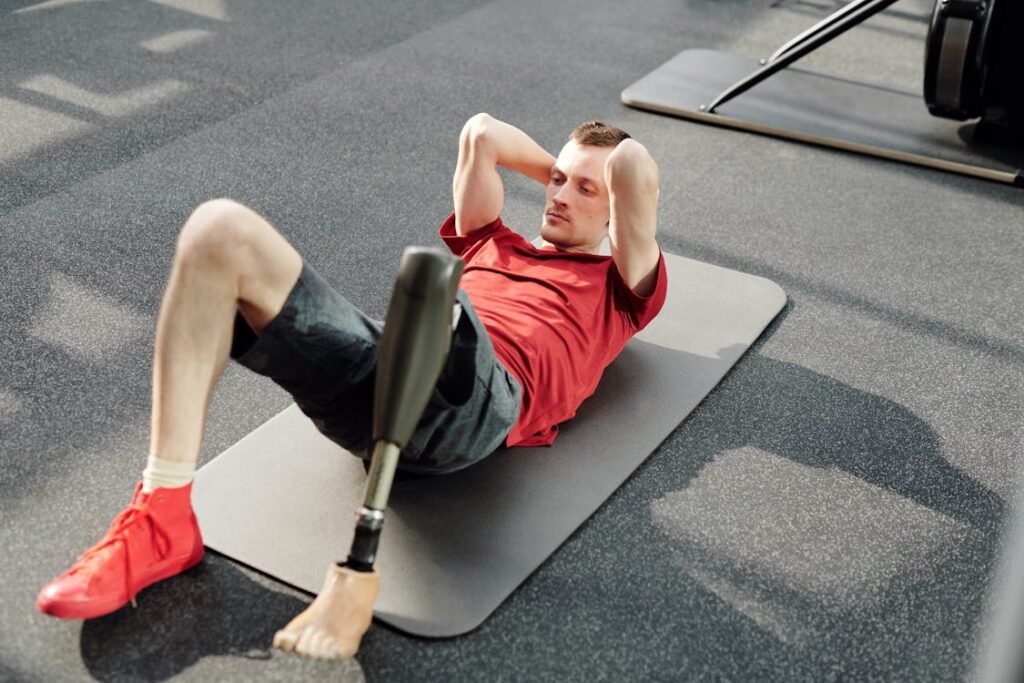
The Evolution of Adaptive Sports Equipment
Adaptive sports equipment has come a long way. In the past, individuals with disabilities had limited options when it came to participating in sports.
Many had to rely on makeshift modifications or struggled with equipment that was not designed for their specific needs. Today, advances in technology and engineering have transformed the landscape of adaptive sports, allowing athletes to compete on a level playing field.
One of the most significant developments has been the use of lightweight materials such as carbon fiber and titanium. These materials have made prosthetic limbs, wheelchairs, and other adaptive gear lighter, more durable, and more efficient.
Athletes no longer have to worry about heavy, cumbersome equipment slowing them down. Instead, modern adaptive gear enhances their performance, making movement smoother and more natural.
Prosthetics Designed for Sports
For athletes with limb loss, prosthetics designed specifically for sports have been a game-changer. Unlike traditional prosthetic limbs, which focus on basic mobility, sports prosthetics are built for speed, agility, and endurance.
Running blades, for example, use curved carbon fiber to provide energy return with each step, allowing runners to move faster and more efficiently.
These prosthetics are designed to mimic the natural motion of a human leg, enabling athletes to sprint, jump, and compete at high levels.
Waterproof prosthetics have also opened up new possibilities for swimmers and surfers. These prosthetic limbs are resistant to water damage and provide excellent grip and flexibility, allowing athletes to move effortlessly through the water.
Some models even have mechanical joints that mimic the movement of a natural foot, making activities like diving and swimming much more accessible.
Advanced Wheelchairs for Competitive Sports
Wheelchair technology has also seen incredible advancements. Sports wheelchairs are now designed to match the unique demands of different sports, whether it’s basketball, tennis, rugby, or racing.
Unlike standard wheelchairs, which prioritize everyday mobility, sports wheelchairs have reinforced frames, angled wheels for better stability, and aerodynamic designs for maximum speed.
For wheelchair racing, athletes use ultralight racing chairs with aerodynamic frames that cut through the air efficiently. These wheelchairs are built for speed and endurance, allowing racers to maintain high velocity with minimal resistance.
The design of these chairs ensures that every push translates into powerful forward motion, reducing strain on the athlete’s arms and shoulders.
Basketball and rugby wheelchairs, on the other hand, are built for agility and impact resistance. These chairs have sturdy frames and reinforced bumpers to withstand collisions.
The wheels are positioned at an angle to provide better balance and quick turning ability, giving athletes more control on the court or field.
Adaptive Bikes for Cycling Enthusiasts
Cycling has become increasingly popular among athletes with disabilities, thanks to adaptive bikes that cater to different needs. Handcycles, for example, allow individuals with limited leg mobility to pedal using their arms.
These bikes are designed for speed and endurance, with lightweight frames and efficient gearing systems that make long-distance cycling more manageable.
Tandem bikes have also become a great option for visually impaired cyclists. These bikes allow an athlete to ride alongside a sighted partner, providing both safety and support.
The design ensures that the visually impaired athlete can focus on pedaling and balance while their partner handles steering and navigation.
Recumbent bikes provide another alternative for athletes who require additional back support. These bikes have a reclined seating position that reduces strain on the spine and allows for a more comfortable ride.
They are particularly useful for individuals with limited mobility or those recovering from injuries.
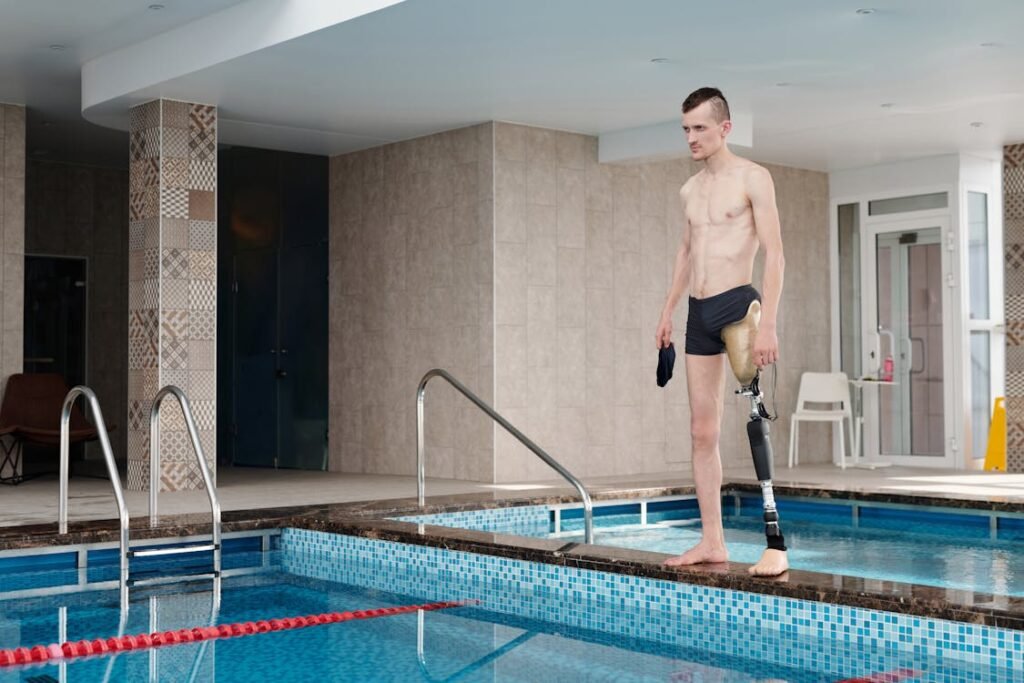
Adaptive Equipment for Water and Snow Sports
Water and snow sports require a different level of adaptability, as they involve balance, body control, and specialized gear to handle changing environments.
Innovations in adaptive equipment have made it possible for athletes with disabilities to compete in activities like swimming, surfing, skiing, and snowboarding with ease and confidence.
High-Tech Prosthetics and Gear for Swimming and Surfing
Swimming has become much more accessible thanks to waterproof prosthetics and specialized support devices.
Traditional prosthetic limbs often struggled in aquatic environments, but modern technology has introduced designs that resist water damage while providing better flexibility.
Some advanced swimming prosthetics mimic the movement of a natural foot or hand, allowing for more effective strokes in the water. These devices help athletes maintain speed and balance without requiring excessive effort.
For those who love the waves, adaptive surfboards provide greater stability and control. These surfboards come with extra-wide bases, support straps, and even handles to help athletes maintain their position while riding waves.
Some adaptive surfers use prone or seated positions, while others rely on custom-designed leg straps to maintain balance. In some cases, mechanical surfboards with built-in assistance mechanisms help riders stay on the board even in rough waters.
Kayaking and rowing have also seen significant advancements in adaptive gear. Adaptive kayaks come with stabilizing outriggers to prevent tipping, while ergonomic paddle grips allow individuals with limited arm strength to maintain a firm hold.
Athletes with spinal cord injuries or limb differences can now enjoy these water sports with the same level of performance as able-bodied athletes.
Skiing and Snowboarding with Adaptive Gear
Winter sports require equipment that can withstand extreme conditions while offering stability and maneuverability. Adaptive skiing has become one of the most popular winter sports for athletes with disabilities, thanks to the development of sit-skis and outriggers.
Sit-skis allow athletes with lower-body impairments to ski while seated, using specialized frames that provide support and control. Some sit-skis use shock absorption technology to make downhill skiing smoother and reduce strain on the body.
For snowboarders, adaptive snowboarding equipment includes customized bindings, balance supports, and reinforced foot straps. These modifications help athletes maintain proper posture while carving through snow-covered slopes.
In some cases, snowboarders use prosthetic legs with flexible ankle joints that mimic the motion of a natural leg, allowing for better control on uneven terrain.
Visually impaired skiers and snowboarders also benefit from adaptive equipment and training techniques. Many use radio communication systems that connect them to sighted guides who provide real-time instructions.
This technology allows them to react quickly to changes in terrain, making the experience safer and more enjoyable.
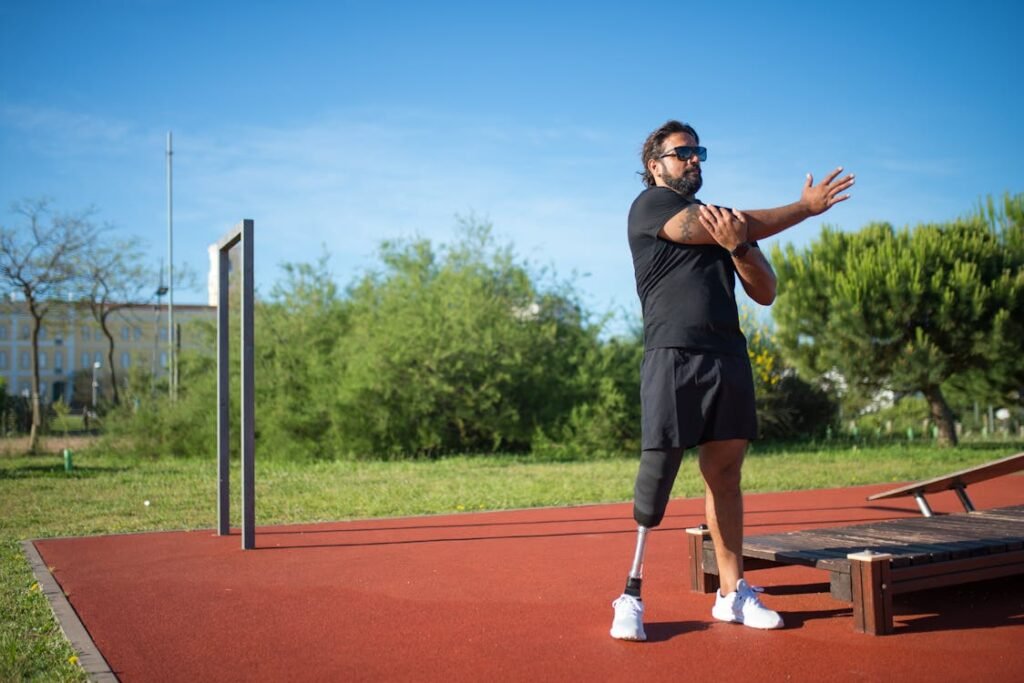
The Role of Technology in Enhancing Adaptive Sports Equipment
Technology is playing a critical role in revolutionizing adaptive sports equipment, making it more advanced, efficient, and customized to an athlete’s specific needs.
From artificial intelligence to 3D printing, new innovations are pushing the boundaries of what is possible in adaptive sports. These advancements are not only improving performance but also making sports more accessible to a larger number of individuals with disabilities.
3D Printing and Custom Prosthetics
One of the most significant breakthroughs in adaptive sports has been the use of 3D printing to create custom prosthetic limbs and adaptive gear.
Traditional prosthetics can be expensive, heavy, and difficult to adjust for different activities. With 3D printing, athletes can now have prosthetic limbs that are lightweight, durable, and specifically designed for their sport.
For example, a sprinter may require a running blade that provides maximum energy return, while a swimmer may need a prosthetic leg with specialized water-resistant materials and streamlined design.
With 3D printing, these prosthetics can be fine-tuned to match the unique requirements of each athlete, offering a perfect fit and superior performance.
Another advantage of 3D printing is the ability to produce prosthetics at a lower cost, making them more affordable for athletes who may not have access to expensive, high-end equipment.
Organizations around the world are using this technology to create personalized adaptive gear, ensuring that more individuals can participate in competitive and recreational sports.
Artificial Intelligence in Adaptive Sports Equipment
Artificial intelligence (AI) is also playing a transformative role in adaptive sports. AI-powered prosthetics and wheelchairs can now adapt to an athlete’s movements in real time, improving speed, agility, and control.
These smart devices use sensors to detect muscle signals, making movements feel more natural and effortless.
For instance, AI-powered bionic limbs can adjust to different terrains, whether an athlete is running on a track, climbing stairs, or navigating uneven surfaces.
This flexibility allows athletes to train and compete without worrying about the limitations of their equipment. Some prosthetics even provide sensory feedback, helping athletes “feel” the ground beneath them for better balance and coordination.
In wheelchair sports, AI-driven wheelchairs are enhancing maneuverability and responsiveness. These wheelchairs can predict movement patterns, adjust for optimal speed, and provide better stability during high-impact activities.
This is particularly useful in sports like basketball, tennis, and rugby, where quick direction changes and precise control are essential.
Smart Wearables and Performance Tracking
Another major technological advancement in adaptive sports is the use of smart wearables that track an athlete’s performance. Devices like motion sensors, heart rate monitors, and pressure-sensitive insoles provide real-time data on speed, endurance, and movement efficiency.
This data allows athletes and coaches to analyze performance and make adjustments to improve technique and reduce injury risks.
For example, a wheelchair racer can use a smart wearable to track push frequency, speed, and arm positioning. By reviewing this data, they can fine-tune their technique to maximize efficiency.
Similarly, a para-cyclist can monitor leg strength and cadence, ensuring they maintain the best posture and pedaling rhythm for peak performance.
Smart wearables are also beneficial for rehabilitation and injury prevention. By tracking muscle activity and joint movement, these devices help athletes recover safely from injuries and avoid strain during intense training sessions.
With AI-powered analysis, athletes can receive real-time feedback and personalized training programs based on their body’s needs.
The Future of Adaptive Sports Technology
As technology continues to evolve, the future of adaptive sports equipment looks incredibly promising. Scientists and engineers are working on exoskeletons that will allow individuals with paralysis to walk, run, and even compete in sports.
Brain-computer interfaces (BCIs) are also being developed to help individuals control prosthetics and wheelchairs using only their thoughts.
These innovations will continue to push the boundaries of what is possible, ensuring that adaptive sports become more inclusive and exciting for everyone.
The combination of robotics, AI, and personalized prosthetics will not only enhance performance but also provide athletes with disabilities the freedom to explore their full potential in sports.

The Psychological and Social Impact of Adaptive Sports
Adaptive sports do more than just provide a physical outlet—they have a deep psychological and social impact on athletes with disabilities. Engaging in sports fosters confidence, builds resilience, and strengthens a sense of community.
The right adaptive equipment not only enables participation but also empowers athletes to push their limits, proving that disabilities do not define abilities.
Boosting Confidence and Mental Strength
For many athletes with disabilities, participating in sports is a transformative experience. The ability to move freely, compete, and achieve goals enhances self-esteem and builds mental resilience.
Adaptive sports help individuals shift their focus from limitations to possibilities, encouraging them to challenge themselves in new ways.
The process of mastering a new sport, whether it’s wheelchair basketball, adaptive cycling, or running with a prosthetic blade, requires dedication and perseverance.
Overcoming initial struggles and gradually improving through training creates a sense of achievement. Athletes gain confidence not only in sports but also in everyday life, realizing they are capable of much more than they once thought.
Additionally, sports provide a healthy way to manage stress and anxiety. Physical activity releases endorphins, which improve mood and reduce feelings of frustration or isolation.
Many individuals with disabilities experience emotional challenges, especially if they have recently acquired their disability. Adaptive sports provide an avenue to channel energy positively, helping athletes develop a stronger and more optimistic mindset.
Building a Supportive Community
Adaptive sports bring people together. Whether competing in team sports or participating in individual activities, athletes form meaningful connections with others who share similar experiences.
This sense of belonging is crucial for emotional well-being, as it helps reduce feelings of isolation and fosters strong support systems.
Many athletes with disabilities find motivation and inspiration in their peers. Training alongside others who have faced similar challenges creates an environment of encouragement and mutual respect.
Seeing a fellow athlete succeed, whether by crossing a finish line or making a crucial shot in a wheelchair basketball game, reinforces the belief that anything is possible.
Beyond teammates, adaptive sports also help bridge gaps between individuals with and without disabilities. Inclusive sporting events encourage greater understanding and appreciation of adaptive athletes’ skills and determination.
As awareness grows, so does societal acceptance and support for accessibility and inclusion in all areas of life.
Opportunities for Career Growth and Advocacy
Many adaptive athletes go on to become role models, coaches, or advocates for disability rights. The experience of overcoming challenges in sports often translates into leadership in other areas.
Some athletes use their platform to push for better accessibility in sports facilities, improved equipment funding, or inclusive policies in professional competitions.
Additionally, sports provide career opportunities in coaching, mentoring, and sports administration. Organizations focused on adaptive sports often seek individuals with lived experience to help develop training programs and advocate for increased participation.
Athletes who excel in their field may even secure sponsorships, paving the way for professional careers in sports.
As adaptive sports continue to gain recognition, more funding and resources are being directed toward providing better equipment, training facilities, and competitive opportunities.
This ensures that athletes with disabilities have the same chance to excel and pursue their dreams as any other athlete.
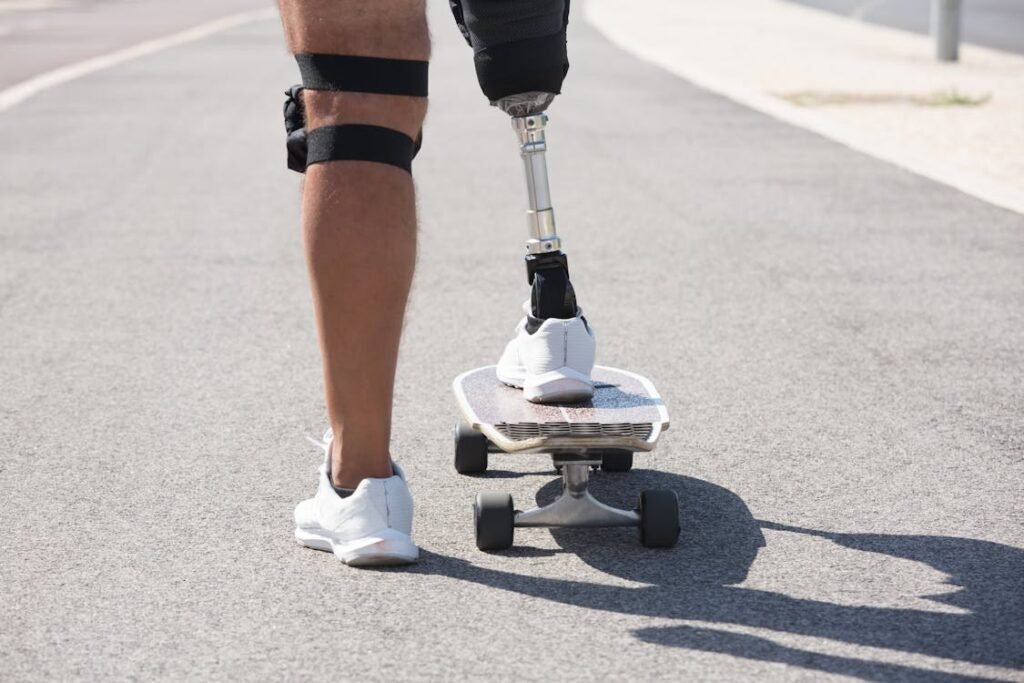
Expanding Access to Adaptive Sports Equipment
While adaptive sports equipment has come a long way in terms of innovation and performance, accessibility remains a major challenge for many athletes with disabilities.
High costs, limited availability, and lack of awareness often prevent individuals from accessing the gear they need to participate in sports.
However, organizations, manufacturers, and communities are working to bridge this gap, ensuring that more people have the opportunity to engage in adaptive athletics.
Overcoming the Cost Barrier
One of the biggest challenges in adaptive sports is the cost of specialized equipment. A high-performance racing wheelchair, a custom prosthetic running blade, or an adaptive snowboard can cost thousands of dollars.
Unlike standard sports equipment, these devices are often custom-made to fit the athlete’s unique needs, which increases production costs.
To address this, various organizations and foundations provide grants and funding assistance to athletes with disabilities. Nonprofits, sports federations, and government programs offer financial support to help cover the costs of equipment.
Crowdfunding has also become a powerful tool, with athletes raising funds through online campaigns to purchase the adaptive gear they need.
Manufacturers like Robobionics are playing a crucial role in making adaptive sports equipment more affordable.
By using innovative manufacturing techniques such as 3D printing, prosthetic limbs and assistive devices are becoming more cost-effective without compromising quality.
As technology continues to evolve, adaptive equipment is expected to become more accessible to a broader audience.
Increasing Availability and Awareness
Another significant challenge is the availability of adaptive sports equipment. Unlike mainstream sports gear, which is widely available in stores, adaptive equipment is often harder to find and may require specialized fittings.
Many athletes have to travel long distances to find a supplier, and some struggle with long wait times to receive their custom equipment.
To address this issue, sports organizations and medical professionals are working to expand distribution networks. More rehabilitation centers and sports clinics are incorporating adaptive sports programs, making it easier for individuals to access equipment and training in one place.
Online platforms are also playing a role, with e-commerce sites offering customizable prosthetics, wheelchairs, and adaptive gear that can be delivered directly to athletes.
Awareness is another key factor in expanding access. Many individuals with disabilities are unaware of the sports opportunities available to them simply because adaptive athletics are not widely promoted.
Schools, rehabilitation centers, and community programs are beginning to integrate adaptive sports into their curriculums, introducing children and adults to the benefits of sports from an early age.
By increasing visibility and representation, more individuals will feel encouraged to explore the world of adaptive sports.
Building Inclusive Sports Communities
Expanding access to adaptive sports equipment is not just about affordability and availability—it’s also about fostering an inclusive sports culture.
Many adaptive athletes face challenges in finding places to train or compete because mainstream sports facilities are not always designed with accessibility in mind.
To address this, more sports organizations are incorporating adaptive divisions into major competitions. Events like the Paralympics and adaptive marathons showcase the incredible talent of athletes with disabilities, inspiring others to get involved.
Local gyms and recreation centers are also becoming more inclusive, offering specialized training programs, accessible equipment, and coaching for adaptive athletes.
Collaboration between adaptive and non-adaptive athletes is another important step toward inclusion. Mixed-ability sports, where athletes with and without disabilities compete together, help break down barriers and foster greater understanding.
As more people recognize the skill and dedication required in adaptive sports, perceptions of disability continue to evolve, paving the way for a more inclusive and equal playing field.
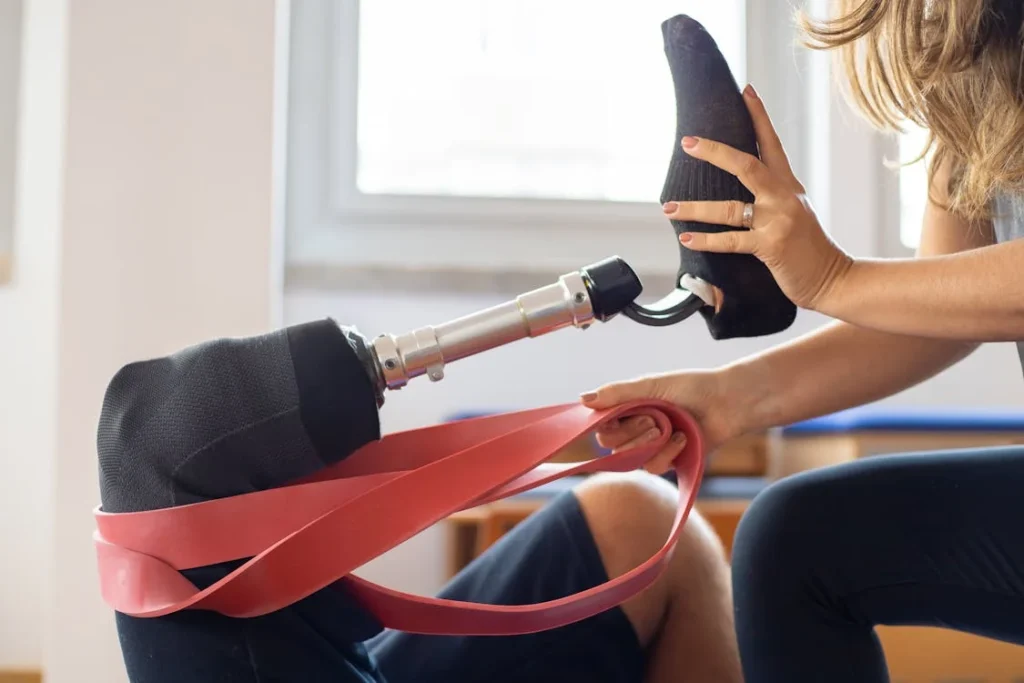
The Role of Innovation in the Future of Adaptive Sports Equipment
As technology continues to advance, the future of adaptive sports equipment looks more promising than ever. Engineers, scientists, and athletes are working together to create innovations that will enhance performance, improve comfort, and provide even greater accessibility.
The next generation of adaptive sports gear will not only be more effective but also more personalized, allowing athletes to push their limits further than ever before.
Smart Prosthetics and AI Integration
One of the most exciting developments in adaptive sports is the integration of artificial intelligence (AI) into prosthetic limbs.
Traditional sports prosthetics rely on mechanical designs to provide movement, but AI-powered prosthetics are capable of adapting to an athlete’s unique biomechanics.
These smart prosthetics use machine learning to analyze an athlete’s motion patterns and adjust in real-time, providing smoother transitions and better energy efficiency.
For example, AI-powered running blades can automatically adjust their stiffness based on the type of terrain, whether it’s a hard track, soft grass, or uneven trails.
This eliminates the need for athletes to switch between different prosthetics for various conditions, giving them more freedom to train and compete in diverse environments.
Another breakthrough is sensory feedback technology, which is bringing a sense of touch to prosthetic limbs.
New developments in neural interface technology allow prosthetic users to “feel” pressure and texture, making sports like climbing, cycling, and weightlifting much more intuitive.
By improving the connection between the athlete and their prosthetic, these advancements will revolutionize how adaptive athletes perform.
Robotic Exoskeletons for Strength and Endurance
Robotic exoskeletons are another groundbreaking innovation that could change the future of adaptive sports. Currently used in rehabilitation settings, exoskeleton technology is evolving to support athletes in high-intensity sports.
These wearable robotic suits use powered joints and AI-driven control systems to enhance strength, endurance, and stability.
For athletes with spinal cord injuries, exoskeletons provide an opportunity to stand, walk, and even run. Future models are expected to become lighter, more efficient, and better integrated with natural body movements, making them suitable for competitive sports.
With advancements in battery life and material design, these devices may soon allow adaptive athletes to compete alongside able-bodied athletes in endurance sports such as marathons and obstacle races.
Adaptive Wearables for Real-Time Performance Monitoring
Wearable technology is becoming increasingly sophisticated, and adaptive athletes are benefiting from devices that provide real-time performance analysis.
Smart wearables, such as biofeedback sensors, track muscle activity, heart rate, and joint movement, allowing athletes to fine-tune their training programs for maximum efficiency.
For example, adaptive rowers can use motion-capturing wearables to analyze stroke efficiency, while wheelchair basketball players can monitor their upper body strength and endurance.
These wearables can also be connected to AI-driven coaching platforms, offering personalized feedback to help athletes improve their techniques.
In addition to performance tracking, these devices are playing a role in injury prevention. By analyzing movement patterns, they can detect early signs of overuse injuries and suggest modifications to training routines.
This ensures that athletes can train harder and longer without increasing the risk of strain or injury.
The Future of 3D-Printed Adaptive Equipment
3D printing is already revolutionizing the field of adaptive sports, but future advancements will take customization to an entirely new level.
Instead of relying on mass-produced adaptive gear, athletes will be able to get sports equipment that is perfectly tailored to their bodies and their specific sport.
New developments in bio-compatible materials mean that 3D-printed prosthetics and braces will not only be stronger but also more comfortable.
Personalized prosthetic liners, designed to match an athlete’s exact limb shape, will reduce pressure points and discomfort, making it easier to train for long hours.
Additionally, the ability to quickly produce customized adaptive gear will give athletes the flexibility to experiment with different designs and find the perfect fit for their performance needs.
In the coming years, 3D printing may also be used to create high-performance sports wheelchairs, adaptive bikes, and custom grips for para-athletes in sports like archery and weightlifting.
As production costs decrease, these advancements will make adaptive sports more affordable and accessible for athletes at all levels.
Conclusion
Adaptive sports equipment has transformed the way athletes with disabilities compete, train, and enjoy physical activity. Innovations in prosthetics, wheelchairs, bikes, and wearable technology have made sports more accessible, allowing individuals to push their limits and achieve new heights. From AI-powered prosthetics to robotic exoskeletons, the future of adaptive sports looks more promising than ever.
Beyond performance, adaptive sports build confidence, create opportunities, and foster a strong sense of community. They prove that disability does not define ability and that with the right equipment, athletes can achieve incredible feats. As technology continues to evolve, accessibility will improve, making it easier for more individuals to participate in sports without barriers.
At Robobionics, we are committed to advancing prosthetic technology to support adaptive athletes in reaching their full potential. If you are looking for high-quality, affordable prosthetic solutions designed for sports, book a free demo of Grippy™ today and experience the future of movement!



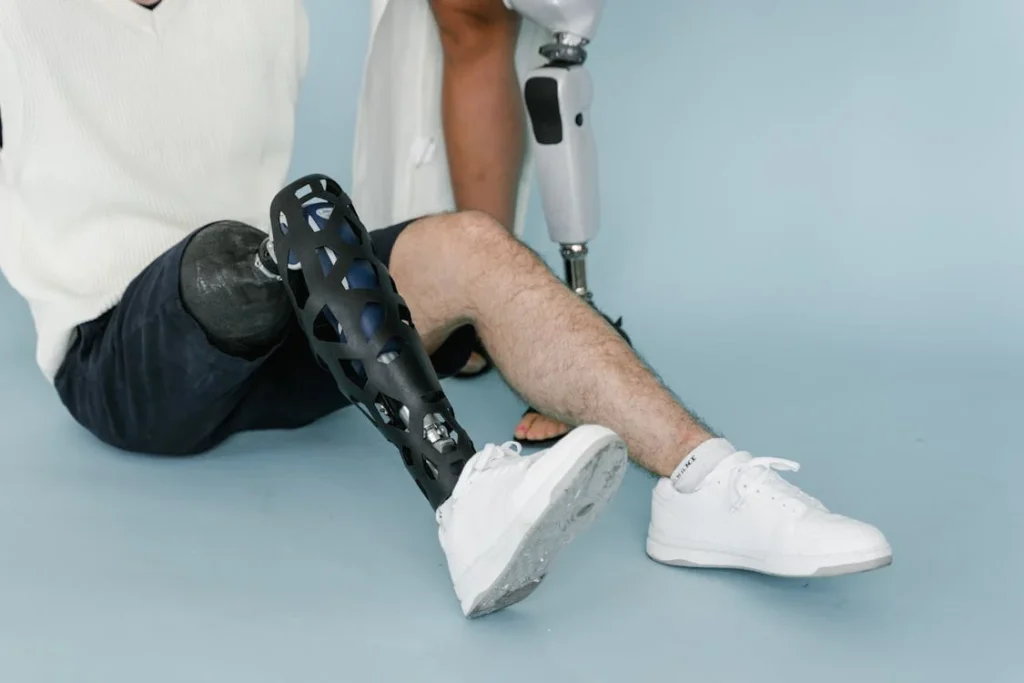
Pingback: Unlocking Access: Inclusive Design in Sports Apparel and Equipment